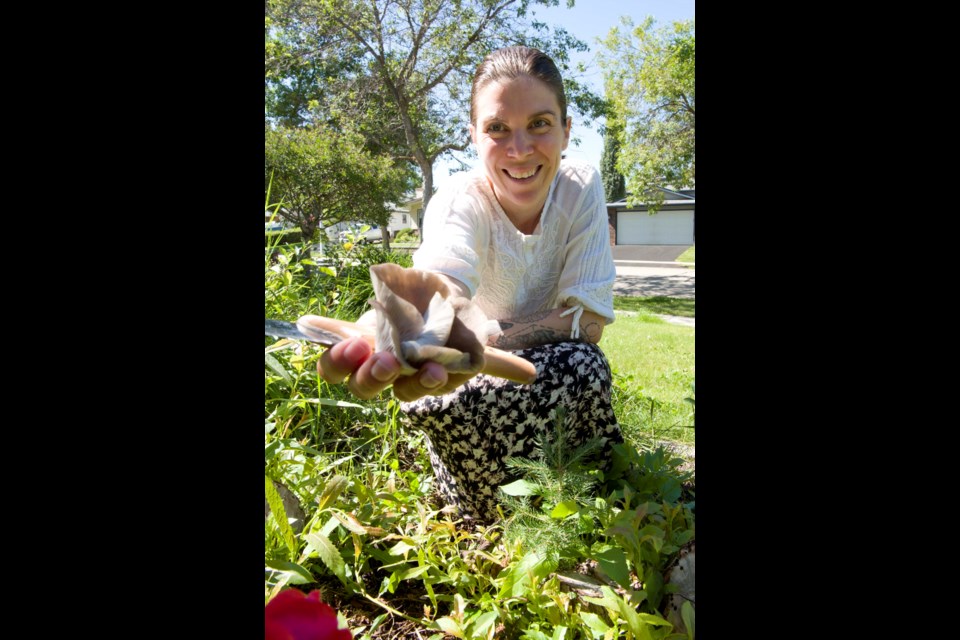Alberta’s annual mushroom festival may be cancelled, but local mycophiles say there’s still plenty of fungal fun to be had in your own backyard.
Aug. 9 was supposed to be the date of the Alberta Mycological Society’s annual mushroom expo at the University of Alberta Botanical Garden.
That event and many of the society’s other summer forays have been cancelled due to the pandemic, said society secretary and Sturgeon County resident Elizabeth Lakeman.
There’s no big show, but you can still look for mushrooms on your own. Lakeman said 2020 has been a fantastic year for wild mushrooms due to all the rain, including brain-like morels, spongy red tops and broad-brimmed shaggy parasols. St. Albert is currently replete with hericium mushrooms, which often look like snow-covered weeping willows.
St. Albert mycophile and city councillor Natalie Joly said she’s been getting delicious shaggy manes in her yard and had spotted many morels, hericiums, and boletes on walks with her kids.
“The mosquitoes are awful and the mushrooms are amazing.”
Grow your own
If you don’t want to roam the backwoods for mushrooms, you can grow your own. Joly started raising oyster mushrooms in her yard this spring, and has been posting photos of the gargantuan results on her Facebook page.
“I’ve had so much that I’ve had to give them away to three different neighbours.”
Joly said she started her garden using kits bought from commercial mushroom growers such as Planet Mushrooms (active at the St. Albert farmers’ market) and Gruger Family Fungi by Nisku.
Rachel Gruger of Gruger Family Fungi said those kits are typically sacks of mulch or chunks of wood that have been pre-treated with fungi in a lab. The white, hairy mycelium of the fungi eats the mulch and wood and eventually fruits, producing a mushroom.
Planting a mushroom garden consists of taking some pre-treated material and dropping it on the ground. Gruger recommended placing your mushroom garden in the same place you’d hang a hammock – some place that’s shady and cool, but not dark and drenched. You can squish your mushroom mulch a bit if you want, but keep it at least six inches thick if you want it to actually fruit.
“Mushrooms love plant companions,” she continued, so she advised planting your mushrooms alongside other crops – the plants provide the fungi with oxygen, while the fungi hold onto water for the plants.
Keep your mushroom patches free of herbicides and pesticides, as the mushrooms will soak those chemicals up, and water them along with the rest of your plants, Gruger said.
Expect to see mushrooms after two to six weeks in mulch and after a year in a log, Gruger said. Make sure to harvest your mushrooms as soon as you see the caps start to curl – that means they’re ripe, and bugs love eating ripe mushrooms.
Joly has blue, golden, and king oyster mushroom patches hidden amongst the tangled vines and branches of her garden. Those patches have proved prolific, with one producing an enormous mushroom cluster that was bigger than her hand.
“It’s a treasure hunt in your backyard,” she said, when asked about the appeal of mushroom gardening.
“You don’t know when they’re going to come up, and you don’t know how many of them are going to come up.”
Joly said anyone with an interest in wild mushrooms should look into mushroom gardening.
“It’s easy and rewarding, and in the worst case you have good ground cover for your garden.”
She urged residents who want to eat garden or wild mushrooms to join the Alberta Mycological Society first to learn which ones are safe to eat.




